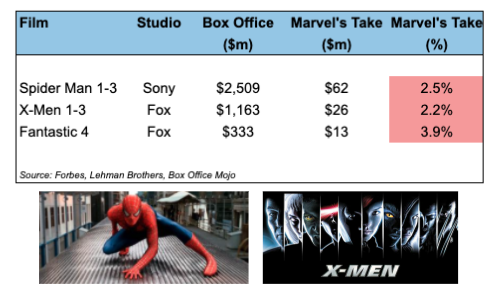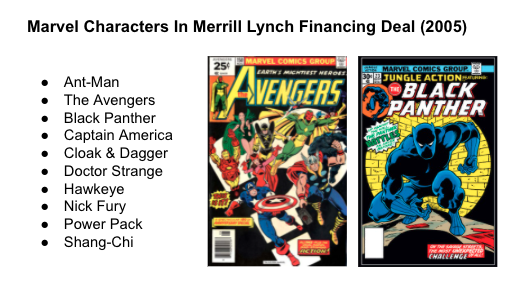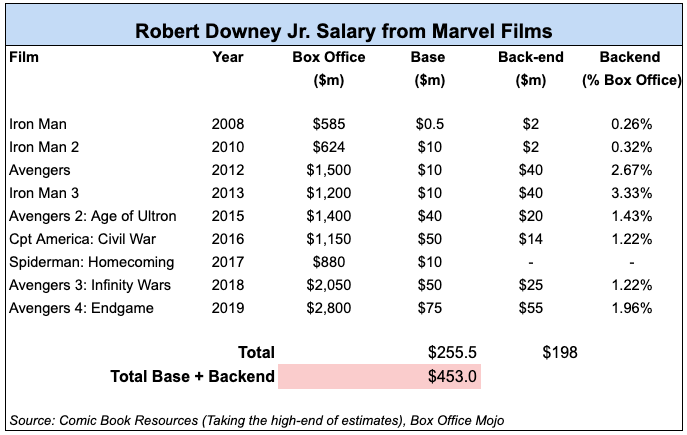
When Iron Man came out in 2008, Robert Downey Jr. was not the big star we know today. In the early 90s, Downey Jr. was one of the brightest young stars in Hollywood, receiving a Best Actor nomination for “Charlie Chaplin” in 1992 at 27 years old. In the second half of the decade, however, he dealt with drug addiction, arrests, and jail stints before going clean in 2001. So how did Marvel change his fate?
Downey Jr was actually in the process of rebuilding his career and was paid a below market rate of US$500,000 when he joined the Marvel Cinematic Universe (MCU). Thanks to that deal, he’s made one one of the greatest acting comebacks ever; to date, he’s earned over US$450 million as Tony Stark. He wasn’t the only one raking in big bucks: Marvel studio’s films have raked in more than US$25 billion in revenue at the box office alone as of 2022 – a far cry from the threat of bankruptcy back in 1996.
Nobody got here by sheer luck: their trajectory was thanks to some savvy financial moves and clever contract negotiation – something that every student at schools like ESSEC Business School learn.
Financials at the heart of Marvel’s revival
Marvel turned to a famous executive who knew a thing or two about saving businesses from the brink of destruction, and through applying basic financial management (general cost cutting of elements like administration and warehousing), the company stabilised.
However, despite the severe cost cutting, Marvel didn’t cut corners on paying its creative talents – the writers, editors, illustrators. This set the stage for Marvel to capitalise on its superpower: its intellectual properties (IP). It made revenue by selling licences for everything from toys to movie rights.
Any good business program, like ESSEC’s Global Bachelor of Business Administration (BBA) programme, teach the basics of all things required for not just starting a business, but also to turn any business around with knowledge of financial accounting, economics, and financial management.
The beginning of the Marvel Cinematic Universe
The lucrative Marvel Cinematic Universe (MCU) that we know today was a long shot back in the early 2000s. Marvel had sold rights to its best IPs like Spider Man, X-Men, and Fantastic 4 throughout the 80s and 90s to other film companies.

From 2000-2007, films based on the IPs made money, but Marvel didn’t get much out of them – on average, they only took in under 3% of the box office takings.

Then in 2005, Marvel made its most transformative move and signed an 8-year, US$525 million financing deal with Merrill Lynch to create films around Marvel’s remaining “B-list” characters like Ant-Man, Black Panther, and Shang-Chi (with the IP as collateral for Merrill):

Marvel had plans for a full Avengers film, and wanted to do a character that never had live-action: they chose Iron Man. In 2007, Marvel went all-in with a budget of US$140 million (its operating cash flow in 2006 was US$158 million) on Iron Man.
Tony Stark was not a traditional muscular superhero, so the studio needed a specific type of actor to convey both swagger and vulnerability. They zeroed in on Downey Jr. because director Jon Favreau wanted him and producer Kevin Feige backed it.
Downey Jr. knew his worth
Downey Jr. may have acting chops, but he wasn’t an action lead, so in their contract negotiations, Downey Jr. took a low base fee (US$500,000) in exchange for a percentage of box office (backend). In what’s known as Integrative Negotiation – another aspect of a business student’s toolkit.
By negotiating for a percentage of box office instead of a higher up-front fee, Downey Jr. managed to bag a lot more money than Marvel could’ve offered. This was a classic win-win deal – in contract negotiation terms, they found their ZOPA (Zone Of Potential Agreement).

When Iron Man (2008) opened, it was a smash hit, raking in US$585 million globally. Downey Jr. himself made US$2 million with the backend. Due to this success, thanks majorly to Downey Jr’s inimitable portrayal, Marvel attracted a major investor: Disney bought Marvel for US$4 billion in August 2009.
Downey Jr.’s next step was even more crucial for himself and the studio: he made himself indispensable. As anyone knows, mediation and negotiations are key to getting the best out of any situation – and schools like ESSEC teach mediation techniques that can be applied to any aspect of life, including getting the best deal out of a contract. So what did Downey Jr. do?
The Iron Man era
Fresh off the success of his first film, Downey Jr. negotiated himself a huge pay raise: a US$10 million base plus backend. The sequel, Iron Man 2 (2010) was released a few months after Disney’s acquisition, and earned US$623 million at the box office, making Downey Jr.’s total haul around a whopping US$12 million.
He didn’t stop there: he made US$50 million ($10 million base and $40 million backend) each in Avengers (2012) and Iron Man 3 (2013). In Avengers 2 (2015), Downey notched up to US$60 million.
By this time, Marvel didn’t make another Iron Man film due to Downey Jr.’s huge leverage – so it diversified and reduced his future screen time by pumping out Avengers, The Hulk, Thor, Captain America, and Guardians of the Galaxy in order to raise the star power of other actors to negotiate some leverage of their own on Downey Jr.

But Marvel hit a snag. Prior to releasing Captain America: Civil War (2016), Chris Evans (who plays the titular role) said he might quit the MCU to pursue directing. So the threat of losing a leading man put Downey Jr. back in the driver’s seat. Even in a reduced role in the movie, Downey Jr. still made a whopping US$64 million ($50 million and $14 million backend). In Spider-Man: Homecoming (2017), Iron Man’s short cameo cost Marvel about US$1 million per minute of screen time ($10 million total!).
The last of the two Avengers films – Infinity War (2018) and End Game (2019) – earned Downey Jr. (with backend), US$75 million and US$130 million, respectively! Across nine films, Robert Downey Jr. has earned an estimated US$453 million from playing Iron Man.
For Marvel, he’s been worth every penny, because without Downey Jr. as Tony Stark, there wouldn’t be a Disney deal or an MCU. Collectively, the 27 MCU films bagged the company over US$25 billion.

Lessons learned from Marvel
As any business student knows, financials are the lifeblood that keeps a company alive. To borrow a metaphor from Marvel: if Marvel is the Iron Man suit, finances are its Arc Reactor, the powerful energetic core that keeps the whole operation running. Marvel’s amazing turnaround is a great case study for any business student, as it puts many practices to use.
If you have interest in turning businesses around (a lucrative area of work itself), or even a love of the entertainment industry, having the right business skills won’t just get you in the door, but could make you indispensable as well.
When you enroll in the ESSEC Global BBA programme, you’ll learn all the fundamentals of business, from the financials to the management and more, that you can put to use in any business. You’ll also get to put knowledge to practice with 10-16 months of intensive global internship programmes. The programme is tailored to make any graduate employable globally thanks to its multi-lingual approach: all students have to be proficient in at least 3 languages upon graduation.
With campuses in Singapore, France, and Morocco, you can find out more information on the ESSEC Global BBA programme, on their website.










